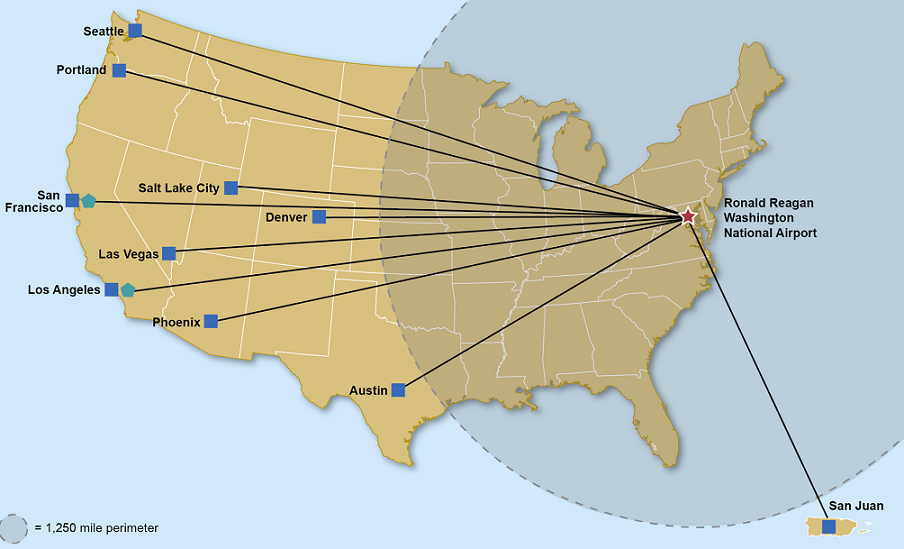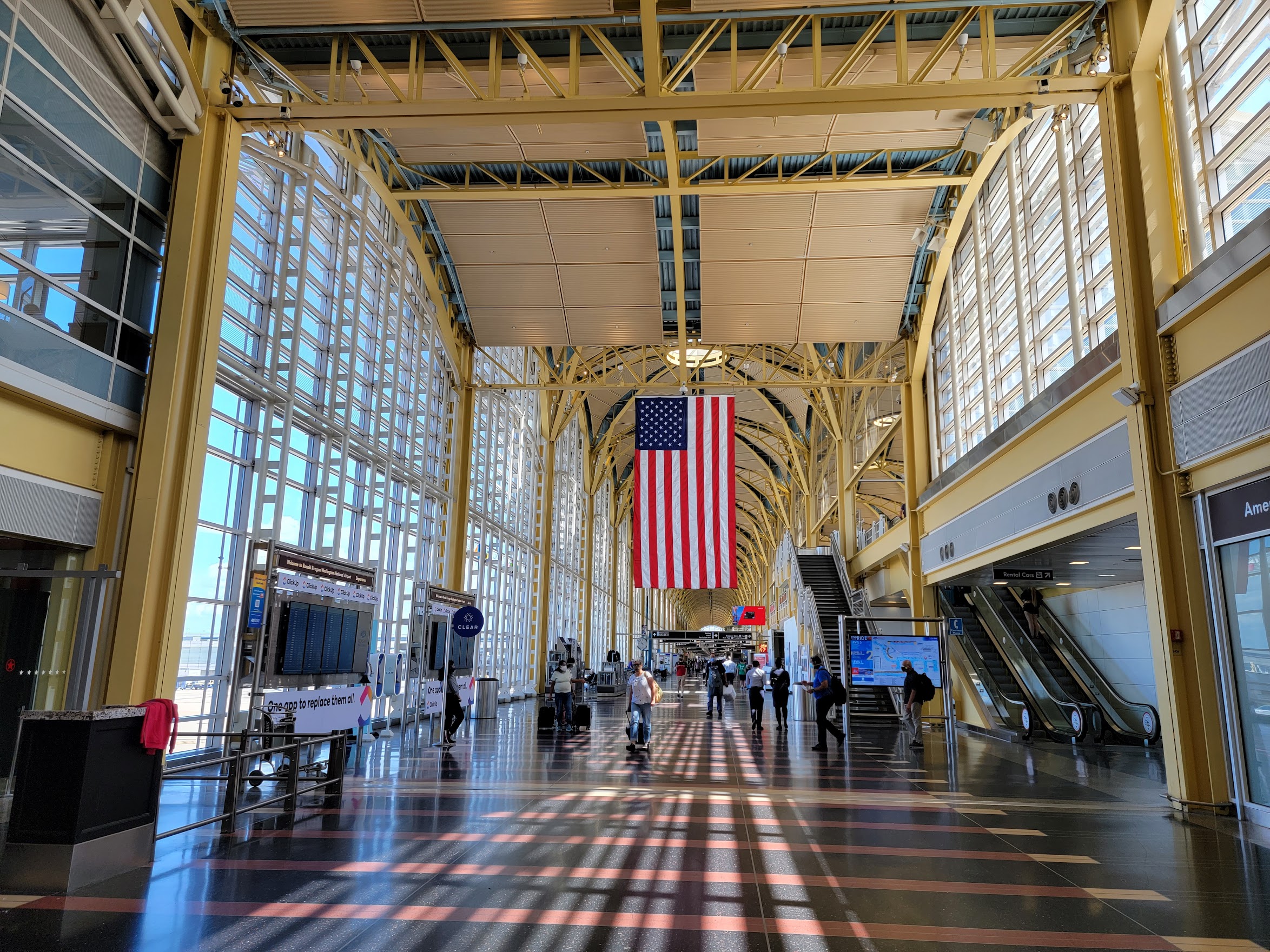A new lobbying effort has spun up to relax the perimeter rule at Washington National airport. Limits are placed on the distance flights can operate from the airport in order to limit congestion and noise and to protect Dulles airport for longer haul traffic.
[The industry group] released a study by Boston Consulting Group, which estimated that expanding the number of long-distance flights at National could reduce ticket prices by an average of $60 and generate as much as $400 million in economic benefits, as well as up to $70 million in additional federal and state tax revenue for the region.
Flights out of ‘DCA’ airport are generally limited to distances of no more than 1250 miles, and have been since 1986. From 1966 to 1980 the limit was 650 miles. Then from 1981 to 1986 it was 1000 miles.
Federal law has carved out ‘exemptions’ three times in the last 20 years, and today there are 20 permitted roundtrips a day to destinations farther than 1250 miles from National airport.
Beyond perimeter destinations are: Austin (Southwest); Denver (Frontier x 3, United); Las Vegas (American); Los Angeles (American x 2, Delta, Alaska); Phoenix (American x 3); Portland (Alaska); Salt Lake City (Delta); San Francisco (Alaska, United); San Juan (JetBlue); Seattle (Alaska x 2).

The new lobbying effort – by Capital Access Alliance, a group incorporated just 8 days ago – points out that the perimeter rule is no longer needed, but doesn’t propose to scrap it, just to add up to 25 more ‘beyond perimeter’ flights.
There are several reasons restrictions remain in place,
- United Airlines lobbies aggressively to keep limits in place, because they do not want to see competition for their flights from Washington Dulles – and passengers at Dulles have been flat for a decade, despite this protection.
National airport subsidizes the cost of flights at Dulles, with $310 million in passenger fees being transferred over to Dulles over 10 years to keep costs lower there (largely a subsidy to United).
- Local community groups argue to keep limits because of noise, although this concern is misguided. It’s generally believed that longer flights mean larger, louder planes. But airlines operate cross country flights today from National airport with Boeing 737s – which are commonly flown on shorter routes as well. Modern aircraft don’t emit the noise that older planes did, and National’s runways can’t support widebody service in any case.

Washington National Airport Historic Terminal
American Airlines is the largest carrier at National with approximately 57% of 5-day or more slots as of 2022, compared to about 12% for Delta and 9% each for United and Southwest. (Delta used to hold more slots but traded those plus cash to US Airways for LaGuardia slots.)
| Airline | Weekday Slot Pairs | % Of Slots | ||
| Air Canada | 16 | 2% | ||
| Alaska | 18 | 2% | ||
| American | 503 | 57% | ||
| Delta | 106 | 12% | ||
| Frontier | 6 | 1% | ||
| JetBlue | 60 | 7% | ||
| Republic | 8 | 1% | ||
| Southwest | 82 | 9% | ||
| United | 82 | 9% | ||
The new lobbying coalition – which doesn’t identify its participants but that the Washington Post notes includes Delta Air Lines, doesn’t support lifting restrictions entirely, since that would primarily benefit American Airlines.
When the Department of Transportation studied the issue of whether the perimeter rule still made sense two and a half years ago, they interviewed a variety of stakeholders not one of which was airline passengers and found that no stakeholder “supported completely lifting the perimeter rule without changing the number or allocation of air carrier slots at Reagan National” i.e. Delta wouldn’t support completely lifting the rule unless they got more slots.

DCA Airport National Hall
Slots themselves, of course, are government subsidies. They allocate limited flights – for free – to airlines (who can then sell those slots, as Delta did at National to US Airways which is why they don’t have more slots there today). And slots keep out new competitors. Congestion pricing would accomplish the same flight limits, without limiting competition, but airlines who benefit from slots won’t support that. The slot system itself should be abolished.
Ironically Washington National has remained under capacity – air traffic control understaffing notwithstanding – because current slot allocations assume 12 private aircraft per hour, however there are almost no private aircraft that are permitted to use the airport due to security concerns.


What’s an alder plane?
a typo?
The perimeter restrictions at both DCA and LGA need to be relaxed; both airports have way more regional jets than other airports which leads to a less efficient use of airspace. It also protects hub carriers at the non-perimeter airport which includes AA B6 and DL at JFK and UA at EWR.
Other sources say the DCA lobbying efforts are being led by DL which still is both the #2 airline at DCA based on number of slots and revenue. They are adding BNA, MCO and MIA service from DCA – not sure with what slots – but DL clearly wants to have a bigger footprint not just in DCA, as it has from NYC and BOS, but also venture more into other airline hubs and focus cities.
United said no. End of discussion.
Unless Delta writes a bigger check to the swamp rats. DC is totally corrupt.
There’s a severe lack of direct flights from non-LAX SoCal airports into both DC airports. The one good option (from LGB) was cut when JetBlue moved from IAD to DCA.
National airport subsidizes the cost of flights at Dulles, with $310 million in passenger fees being transferred over to Dulles over 10 years to keep costs lower there (largely a subsidy to United). — this is insane
It seems Delta wants slots for SEA & more of LAX.
Not really sure an arbitrary 25 slots need to be incremental to the DCA slot pool (if the airport can actually handle 25 extra slots, there’s no need for that to be tied to perimeter flying or not and the airport would be better served giving those to LCCs or ULCCs vs DL & AA) but it would certainly make sense to remove the perimeter rule at DCA or create a “Up to ~25 daily slots can go outside the perimeter” new add to the DCA perimeter rule book. There are plenty of major cities that would benefit from a nonstop to the nation’s capital. The much-touted silver line to Dulles is a bit of a joke from DC proper. It’s an hour to go from Metro Center to Dulles on the silver line. Given traffic some days on I-66, that’s probably useful but with planning, a drive to Dulles seems much faster.
Get rid of the $310 Million subsidy and remove the slot restriction at DCA. United loses their monopoly and DCA gets more flights. Plus, it’s not like the planes are gonna get any louder.
AA should support this only if they get exclusive DCA to LHR routes, which they can service with their new XLRs easily. It would be a huge advantage for them.
Not gonna happen. Part of the restriction is not just to prevent long-haul flights from happening to protect Dulles but also to protect the number of direct flights to smaller cities important to the Congresscritters from those districts. Does anybody really think that American would waste slots flying to Akron and Baton Rouge if they could add more capacity to the west coast? Definitely not.
AA has more than enough slots to serve the small cities they want.
UA does not need protecting.
DL has the ability through its lobbying partners to strike a chord w/ consumers.
Even if low cost carriers get a proportional percent of outside perimeter slots, there is no reason to maintain the status quo that protects two carriers.
The same principle applies in NYC so this isn’t just about DL gaining more access.
WN would also benefit by reallocating its slots to longer haul routes.
I predict eventual success if not in the current route of funding.
Slots are not “government subsidies.”
A subsidy is when you give someone money, get nothing in return, and somebody else benefits.
Essential Airline Service subsidies are actual subsidies.
The slots are an artificial limitation on supply which presumably will drive up the price if demand is otherwise the same. That doesn’t say that an airline will automatically make a profit.
If anything, slots keep airlines and their passengers from cost shifting their business to people who would otherwise suffer more air pollution and more noise.
goforride,
I like your comments.
do stick around.
Slots are NOT subsidies. They are licenses to operate in a limited capacity environment, not unlike radiofrequency licenses.
The difference is that slots are considered permanently held by airlines as long as minimum usage requirements are met which is why the legacy carriers hold most of them; they have simply operated them long before the current slot controls were put in place.
Slot controls exist to maintain operational control – there should be enough to reflect the capacity of the airport but not more.
Perimeter restrictions even further restrict capacity because perimeter restrictions prohibit the maximum usage of the slot – which could be for a flight w/ a larger aircraft to the other side of the country. When you limit half of the states from having access to an airport, the airports that do receive service are not as efficiently served as they should be.
Delta is not asking to gain more slots; it is simply asking to be able to use the slots it does have in the most efficient manner.
The regional jets are used as pawns in a political chest game.
Trunk line jets (B737, A220, & A320) would add 10-15% PAX capacity and make room for West Coast service.
As for Dulles, the Silver line can accommodate just so many PAX. Not sure if an express service is possible based on the configuration of the Silver line.
@Tim Dunn –
“Slots are NOT subsidies. They are licenses to operate in a limited capacity environment, not unlike radiofrequency licenses.”
A government grant of a limited resource to one company, to the exclusion of another, is a….
“Slot controls exist to maintain operational control – there should be enough to reflect the capacity of the airport but not more.” They’re not the only mechanism that would accomplish this, and even if you use slots the grants don’t have to be permanent or free.
Gary,
other people have done a far better job of you of explaining that slots are not subsidies. Slots are an exclusionary license which is granted to some users
But you also are incorrect in assuming that any airline can just add a n unlimited number of flights at any other airport just because they want to.
Any NEW ENTRANT in the US is required to be accommodated by any federally funded airport but there is no requirement that any incumbent airlines can demand more space if it doesn’t exist or that other larger incumbent airlines have to give up flights in order to allow smaller airlines to grow simply does not exist either in the US or by international regulation.
I sure would love AA to throw an E75 or 319 at AUS